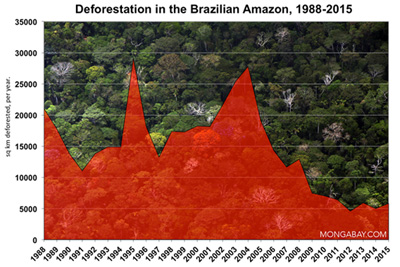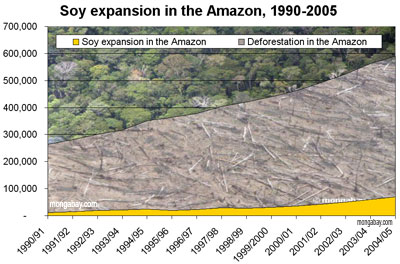Amazon deforestation in Brazil falls 31% for 2007
Amazon deforestation in Brazil falls 31% for 2007
Rhett A. Butler, mongabay.com
August 13, 2007
Deforestation in the Brazilian Amazon fell 31 percent for the 2006-2007 year, compared with the prior period, according to preliminary estimates from Brazil’s National Institute for Space Research (INPE). The loss of 3,707 square miles (9,600 square kilometers) of rainforest was the lowest since the Brazilian government started tracking deforestation on a yearly basis in 1988.
Deforestation rates in Brazil have fallen by more than sixty percent since 2004 when a near record, 10,590 sq mi (27,429 sq km) were destroyed.
Brazil credits the drop in deforestation rates to stepped up law enforcement efforts, which have netted hundreds of illegal loggers and corrupt officials, while generating some $1.7 billion in fines, according to the Brazilian Institute of the Environment and Renewable Natural Resources. The government has also dramatically expanded the extent and number of protected areas, setting aside more than 100 million hectares of the Amazon basin from development since 2002.
 Deforestation in the Brazilian Amazon fell by more than 60 percent between 2004 and 2007.
|
Scientists say that while these measures have helped, lower commodity prices are more likely the primary reason behind slowing forest conversion. Agricultural production — namely cattle and soybeans — and land speculation tied to moves in Brazil’s currency are leading drivers of deforestation in Brazil.
“Despite the good news, however, most observers agree that low prices for beef and soy exports, and the strong Brazilian currency, have also played a major role in reducing Amazon deforestation,” William F. Laurance, a scientist at the Smithsonian Tropical Research Institute and a widely recognized expert on deforestation in the Amazon, told mongabay.com. “The big concern is that rates of forest loss may well rise again once the Brazilian currency falls, or commodity prices increase, either of which would make beef and soy exports more competitive and thereby increase pressures on surviving forests.”
Nevertheless, Laurance welcomes the reprieve, even if temporary, in the deforestation rate.
“It’s very gratifying to see deforestation rates declining in the Brazilian Amazon since 2005, especially given that forest loss from 2002 to 2004 was the worst in the history of the Amazon. I think this demonstrates what can be achieved when the Brazilian government makes a concerted effort to crack down on illegal logging and deforestation,”
RELATED ARTICLES
Amazon deforestation rate falls to lowest on record
(8/10/2007) Deforestation rates in the Brazilian Amazon for the previous year were the lowest on record, according to preliminary figures released by INPE, Brazil’s National Institute of Space Research. Between August 1, 2006 and July 30, 2007, some 3,863 square miles (10,010 square kilometers) of rainforest were cleared, a 28.7 percent drop from 2006 when 5,419 sq ml (14,040 sq km) were lost (2006 figures recently revised from 13,100 sq km). Deforestation rates have fallen sharply — 63.5 percent — since 2004 when 10,590 sq mi (27,429 sq km) were destroyed.
 |
U.S. ethanol may drive Amazon deforestation
(5/17/2007) Ethanol production in the United States may be contributing to deforestation in the Brazilian rainforest said a leading expert on the Amazon. Dr. Daniel Nepstad of the Woods Hole Research Center said the growing demand for corn ethanol means that more corn and less soy is being planted in the United States. Brazil, the world’s largest producer of soybeans, is more than making up for shortfall, by clearing new land for soy cultivation. While only a fraction of this cultivation currently occurs in the Amazon rainforest, production in neighboring areas like the cerrado grassland helps drive deforestation by displacing small farmers and cattle producers, who then clear rainforest land for subsistence agriculture and pasture.
Amazon deforestation
(8/10/2007) Between May 2000 and August 2006, Brazil lost nearly 150,000 square kilometers of forest—an area larger than Greece—and since 1970, over 600,000 square kilometers (232,000 square miles) of Amazon rainforest have been destroyed. Why is Brazil losing so much forest? What can be done to slow deforestation?
